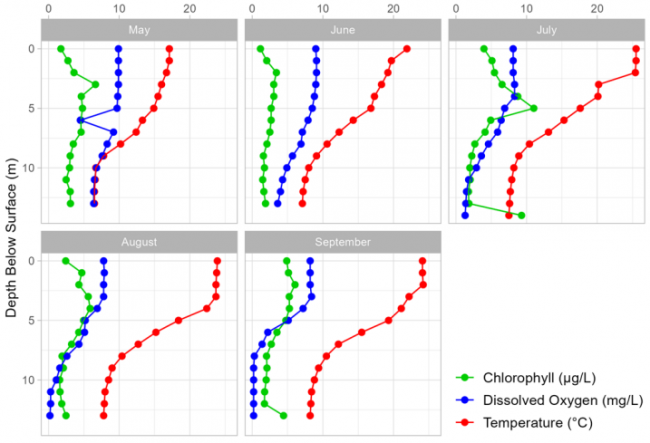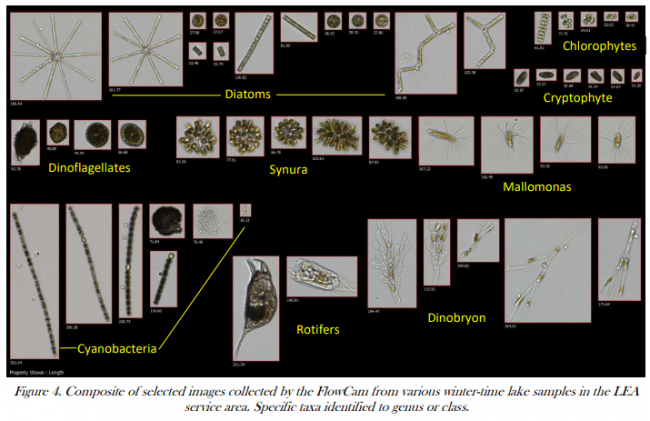
Keyes Pond’s monthly fluorescence, oxygen, and temperature profiles. Chlorophyll concentration (green line), dissolved oxygen concentration (blue line), and temperature data (red line) were collected at every meter from the surface to the bottom from May through September.
May – LEA’s water testing team collected the first fluorometer profile in late May. At that time, Keyes Pond was stratified. In the upper waters, fluorescence values increased until reaching their peak at 3 meters. In the middle and deep waters, fluorescence gradually decreased. A sharp decrease in dissolved oxygen can be seen at 6 meters. This oxygen decrease could have been produced by decomposing algae sitting on top of colder, denser water or it could be an anomaly.
June – In the upper waters, fluorescence values increased until reaching their peak at 2 meters. Below the peak, fluorescence values decreased and remained fairly uniform throughout the rest of the water column.
July – Warm surface waters provided algae favorable growing conditions, noted by the elevated fluorescence readings in the upper waters. Fluorescence values increased until reaching their peak at 5 meters. This is likely where the colder, denser water provided algae a place to “sit”. In the middle waters fluorescence values gradually decreased. Values in the bottom waters were low and remained fairly uniform. The spike in values at the bottom was likely caused by sediment interference.
August – Warm surface waters continued to provide algae favorable growing conditions, noted by the elevated fluorescence values throughout the upper waters. Fluorescence values were highest at 4 meters. In the middle waters, fluorescence values decreased before increasing slightly in the deeper waters. The slight fluorescence increase at the bottom could have been caused by interference from bottom sediments.
September – In the upper waters, fluorescence values gradually increased until reaching their peak at 2 meters. In the middle waters, fluorescence values gradually decreased. Values in the bottom waters were low and fairly uniform. The increased fluorescence values at the bottom were likely caused by sediment interference.
Synopsis: Algae concentrations were moderate in the upper water column throughout the season. An elevated reading was observed near the thermocline in July. Algae concentrations in the deeper waters were low to moderate. High readings in the bottom waters were likely caused by sediment interference.
Gloeotrichia echinulata (a type of cyanobacteria (blue-green algae) commonly found in low-nutrient waters) can be seen with the naked eye. Gloeo density is reported as a value ranging from 0 – 6, based on the number of Gloeo colonies seen through a Secchi scope. Higher values indicate more Gloeo colonies. Gloeotrichia echenulata colonies were not observed in Keyes Pond in 2023.

